The dressage at Tokyo was a real triumph for the Lusitano breed – with five Lusitanos competing with distinction in the Grand Prix.
Here’s a selection of photos taken by Lily Forado…
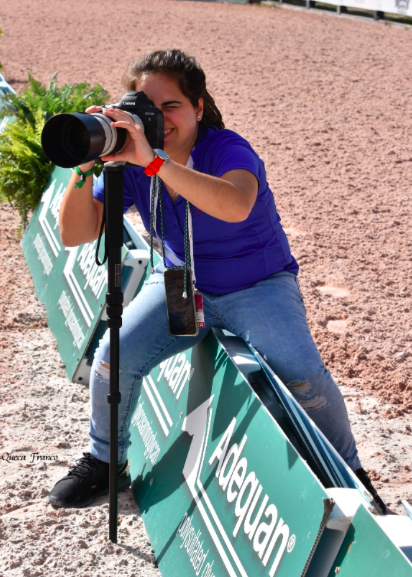
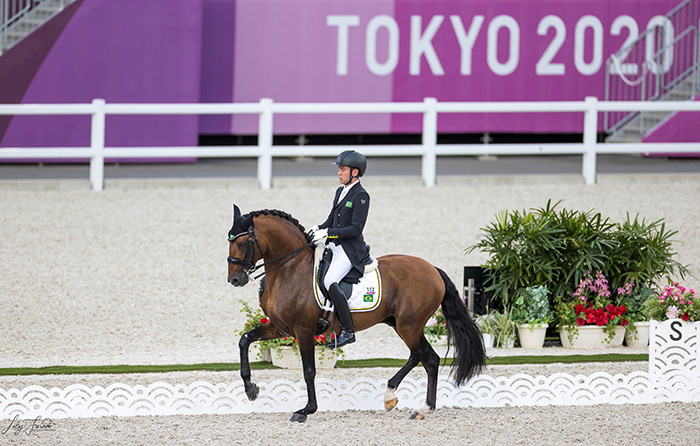
Escorial (Spartacus) and Brazil’s Joao Oliva
Portugal’s Maria Caetano and Fenix de Tineo (Rubi)
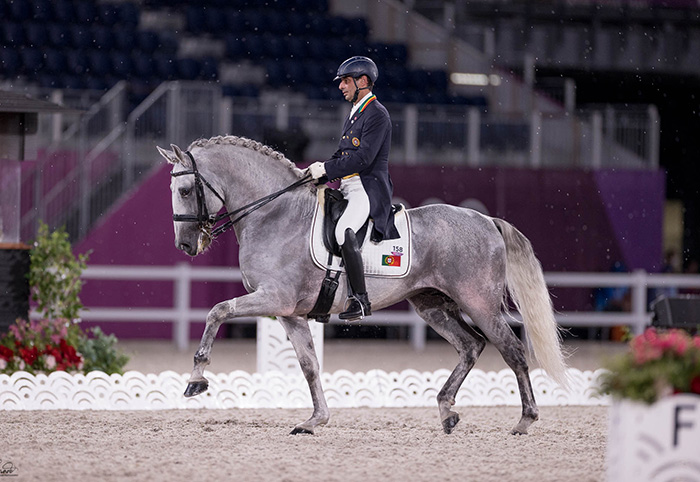
Another for Portugal, Rodrigo Torres and Fogoso (Rico)
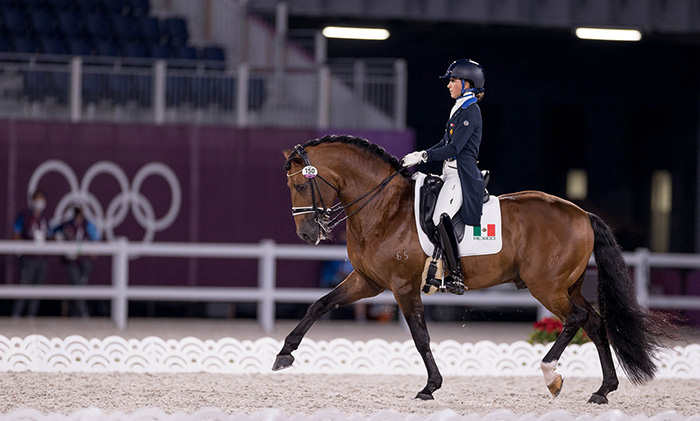
Mexico’s Beduino Lam (Dardo II) and Quirarte del Valle
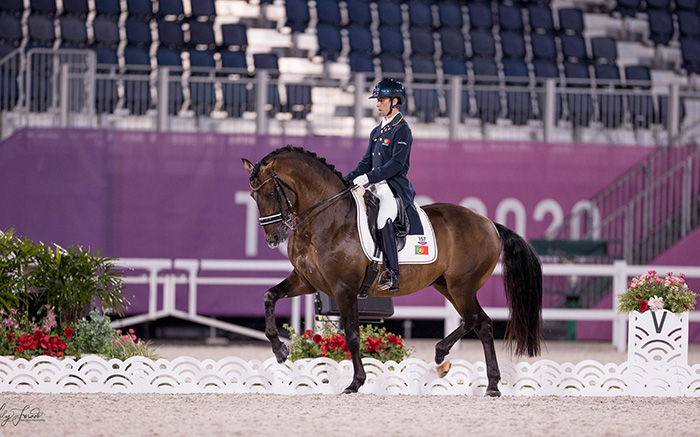
Another for Portugal, Joao Torrao and Equador (Quo Vadis)
The success in Tokyo is not something that happened overnight, it was the result of lots of hard work, intelligent breeding and vision. I was lucky enough to be in on one of the key moments – a seminar in Lisbon a decade ago, here you will find some of the key characters and horses that made the journey possible… CH
Story – Christopher Hector & Photos – Roz Neave and archives
Organizing a Seminar in Portugal is a bit of an oxymoron, things are not so much organized as they happen in this charming country, and so it was with the 1st International Seminar for the Pure Bred Lusitano in Dressage, held in Lisbon in October 2009… it happened to distinctly Portuguese rhythms but with a distinguished array of international experts and guests and started with a very Portuguese line up of dignitaries each with their own little welcoming address on the first morning…
The first person to actually present a paper was Arsénio Rapioso Cordeiro, an historian and authority on the history of the Lusitano breed. He is one of those breed true believers, tracing the development of the Lusitano to the fact that the Iberian Peninsula was spared the effects of the Second Ice Age. Horses had been bred for 7000 years for war and to work cattle, and that explained the character of the Lusitano, which has been fixed as a result of this long period of selection.
“By the Seventeenth Century, the Iberic horse was recognized as the best in the world for the equestrian arts…”
According to Mr Cordeiro, it was only in the past 200 years, that the breed had ‘suffered’ the influence of foreign blood, with horses coming from Normandy in France to Spain and then to Portugal, in an effort to increase the size. There was also a little Arabian influence since the time of Napoleon, but he concedes that ‘all these influences were not bad – it gave some good points, more strength and better hocks’.
In reply to those who suggested that the Portuguese breeders should change their horses more towards the modern Warmblood type, he argued “they are forgetting that dressage came from here, not from Germany. The first Riding Academies were in Italy, Spain, France and Portugal. Our horses are naturally talented for dressage, there is no cold blood influence for size and strength, yet often the qualities that are essential are not visible to the eye, the character is a development of thousands of years of unique rideability.”
“Our horse can guess the thinking of the rider, this empathy with the rider is not a result of domestication, it is a marriage. Of course we can improve. We can make our horse better and bigger, but we must not forget his origins. Because of the introduction of the bigger horses from Normandy, 2/300 years ago, you can find some big horses and take advantage of that, but it is not just size. We must be careful not to lose the agility.”
And of course, since the Iberic horse was the ancestor of all the modern horse breeds, then of course, the latest dressage sensation, Totilas, is just a Lusitano in disguise – ‘what is this horse Totilas but a great great grandson of a father from Iberia?’ One puzzled member of our little travel group approached me in the break, ‘I didn’t know Totilas was a Lusitano…’
To which I replied that he was a Lusitano like we were too related since we both descended from Adam and Eve. Historians like Mr Cordeiro can be dangerous, so entranced with the romance of history that they tend to encourage breeders to breed for the past rather than the future… At this stage I was getting a little worried that the Seminar would descend into an orgy of self-congratulation, since the Lusitano the perfect horse, why change? In fact I suggested that they might screen Totilas’ test then-and-there as something of a reality check.
This didn’t happen but the thinking did get a little less romantic and a little more analytical with the next speaker, João Ralão Duarte from the Lusitano Breeding Association. He detailed the way since the 90’s that the emphasis had changed from breeding for type to performance. Since 1993, all the stallions need to be ridden, not at home, but in public, and only inspected stallions were allowed to breed. According to João: “Around 2000 we started to think more seriously about functionality and established merit books.”
Stallions could enter these merit books on the basis of their progeny, if they had good performers in bull-fighting or equestrian sport.
“The breeders want more and more horses that can do something, and so we introduced a star ranking with the top horses getting either four or five stars.”
To gain these stars the horses are assessed for gaits at liberty, and then in dressage or Portuguese Equitation. They are also given a ‘free’ test to show what they do best, before they are ridden by two test riders.
As a result of these measures the number of Lusitanos competing in dressage has risen dramatically.
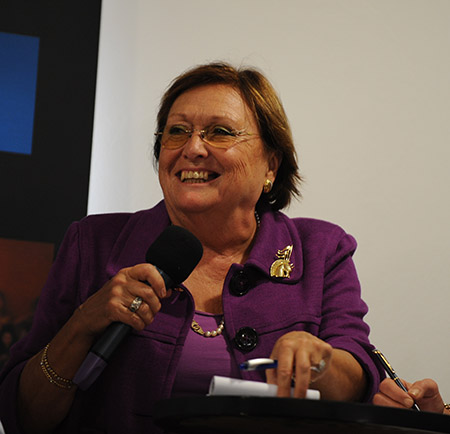
The discussion was continued on by a panel of experts that headed by former FEI dressage head, Mariette Withages, who now seems to be technical delegate to most of the world’s most important competitions. Mariette wondered if the breeders were in agreement that changes were needed to make the Lusitano competitive in the highest levels of competition dressage?
Another panelist, Paulo Caetano was one of the great stars in the bull-fighting ring. He is a tall man with enormous presence and charm – later our group were lucky to see him ride, and he sits a horse with the same quiet gravitas as he speaks.
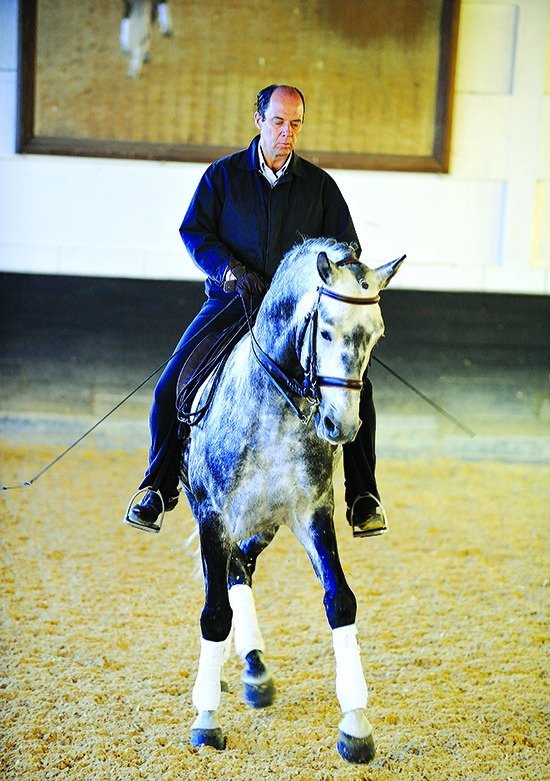
“Bull-fighting is dressage with drama, it goes to the vital meaning of equitation – control. If you can’t control every step, you can get hurt and your horse can get hurt. As a bull-fighter, I became a breeder because we needed better horses…. The best bull-fighting horse has the same characteristics as the dressage horse, we face the same challenge: find more strength, more movements. We kept the shoulder movements but we need the engine, a good back to transfer power with lightness. We should think about the future not the past, and we need stronger horses with better walk, more swinging back, more over-track. Seventeen years ago we didn’t have good enough bull-fighting horses, now we have them, some of the best horses in the world, not the best dressage horse, but we will try…”
(Paulo only recently retired from the bull-fighting arena and now he only rides on special occasion, to watch him in action, try www.youtube.com/watch?v= YJABJsHbGhY and it’s alright Felicity, in Portugal they do not kill the bull…)
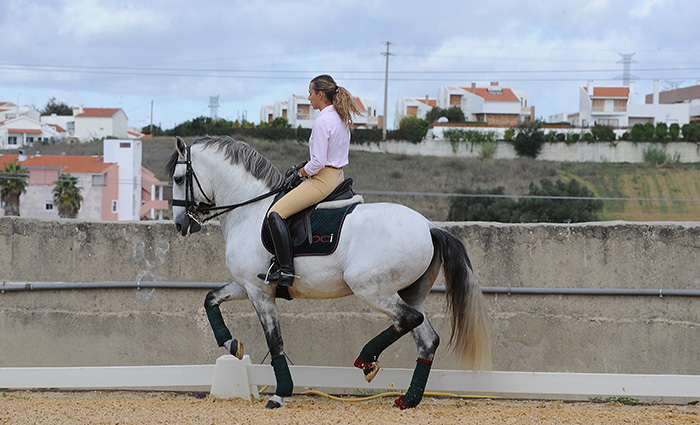
Paulo’s daughter, Maria, is currently a member of the Portuguese dressage team and it would seem Paulo is trying to emulate his success in producing bull-fighting horses by now breeding dressage horses. Maria retired her team horse, the German bred gelding, Diamant by Donnerhall, in December, and will try for the team to the 2010 WEG on the eight year old Lusitano, Útil. After the Seminar, our little travel group headed up by Miguel Távora, dropped in on the Caetano training stables to watch Maria and Útil in action and sure, the canter needs improvement, but it is a very impressive performer for one so young.
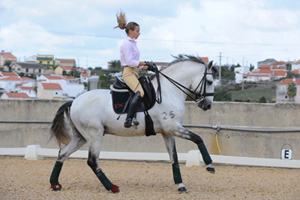
It was one of the questioners from the floor Bento Castelhano, who, so to speak grasped the bull by the horns, raising the dreaded subject of trying to make progress in a closed Studbook: “Biology teaches us if we try to select for everything, there is no progress. The problem is that with a closed Studbook we are not introducing the characteristics we want to the gene pool. We have to create stages in our selection process and not try to select for everything, or we get nothing.”
Despite the fact that the Austrian vet, Robert Stodulka is something of a true believer in the Baroque Horse, and decries the changes in type in the Andalusian, he himself made the point that the Iberic horse is shorter with different angles from the modern sport horse which has long lines. The Warmblood’s long shoulder and a long croup make it very powerful in its forward movements, while the Spanish horse’s movements were are high, rather than long. He asked the question, ‘can we have both the high movements and the long ones?’ Stodulka pointed to some of the movement problems of the Iberian horse, noting while they tended to have a nice forward trot, they have a tendency to lose rhythm in the walk, and a tendency to a four beat in canter (celebrated by the Old Masters as a School Canter).
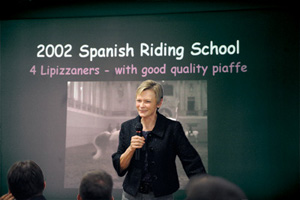
Professor Hilary Clayton of Mary Anne McPhail Equine Performance Center at the Michigan State University has spent the past 30 years researching just how horses move and thanks to the McPhail endowment has a unique facilities and technology to do just that. Hilary is a dressage rider herself, with an especial taste for the Lusitano horse.
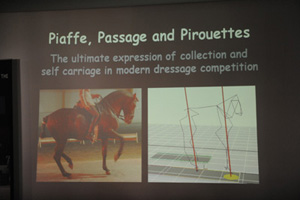
She outlined how using force plates she was able to establish for once and for all that there is no moment of suspension in the piaffe.
“Both trot and passage have an aerial phase, but in piaffe there is no aerial phase. I tend to use the word ‘aerial’ rather than ‘suspension’ because when you say suspension, people think about a leg suspended in the air, not about all four off the ground, which is what I am talking about… in the piaffe it is like the diagonal movement of trot but the movement itself has more like the mechanics of the walk.”
Back in 1997, at the University of Utrecht, Hilary examined four Warmbloods, ridden by Tineke Bartels. Looking at the video, she was convinced that the passage was similar to the trot, but the piaffe was similar to the walk.
“But then a lot of people said that the lack of an aerial moment in piaffe was a defect of the modern sport horse…”
So Professor Clayton contacted Arthur Kottas of the extremely traditional Spanish School in Vienna, and she examined four horses that he considered to have a very good piaffe… and none of them had a moment when all four feet were off the ground, in their piaffe steps there was always at least one foot in contact.
Hilary’s own trainer is long time Nuno Oliveira student, and now US resident, Bettina Drummond, and she brought some of her horses to the McPhail Centre. A biomechanical examination of her horses revealed that in passage it was the hip joint that was entirely responsible for the lift off and swing and that the passage was a very close relation to the trot. Interestingly and somewhat surprisingly, Hilary found most of the bending of the haunches in the piaffe occurred at the fetlock joint.
“This was not what we imagined – the primary muscles were the hamstring muscles. When you look at a dressage horse from behind, pear shaped is good with the horse bulging at the stifle.”
Now I would have thought that the lack of a moment of suspension in the piaffe was fairly obvious, but this provoked a quite heated reaction from the audience, with one delegate suggesting that even if it hadn’t happened yet, he was working on it…
There was also quite a lot of discussion of ‘lightness’, with Paulo Caetano suggesting that the problem of lightness was ‘the big problem of our equitation, everyone confuses lightness with lack of contact but without contact there is no control, and dressage is about control.’
Our own Miguel Távora, very much the honored guest in his native country, summed it up well: “Lightness is nothing more than the horse, because he is totally balanced, being able to respond to all our aids. Lightness and contact are not connected – contact is communication. When the horse is perfectly on our aids, then the horse is light, brilliant but not spectacular.”
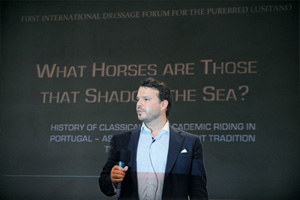
One of the more interesting papers was presented by the chief mover and shaker of the forum, Bruno Caseirão. Bruno is an academic, and his was a wonderfully romantic contribution with the title: A History of Classical and Academic Riding: Horses of the Sea.
They were horses of the sea because when the Portuguese Empire was at its height, the horses went with them. “Portugal is the oldest country in Europe and horses are very connected with our culture… we are looking at a very old tradition of truth and beauty – the aesthetic dimension was always connected with our riding, it’s a spiritualised riding tradition.”
“It was our King Duarte who wrote the first book on equitation since Xenophon… it was the first work on equitation of the fifteenth century, before even the better known work by Grisone.”
“Then in 1910, we became a Republic and Mestre Miranda, the Riding Master to the King became unemployed. Miranda was influenced by Fillis, and he in turn was the teacher of Nuno Oliveira, to whom he was related. Nuno was a student of the old books of equitation, but he combined the writings and tried them in his practice. Through Nuno, Portugal started to market the Lusitano horse to the world combining the myth of the breed with the poise and elegance of classical riding.”
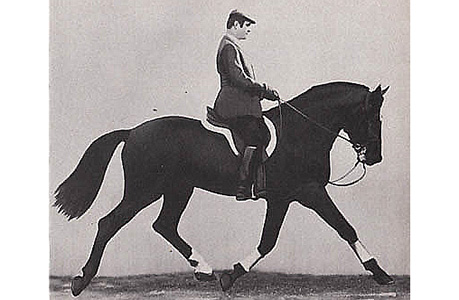
“One of the most important things of Nuno are his heirs, his best students who were all different from the Master. There was Diogo de Bragança, a Baucherist, and the author of the French Riding Tradition (1977). There is the international dressage trainer, Miguel Távora. There is José Athayde, who revolutionized the Alter Stud by starting to ride the mares, and who developed a better riding technique of the stallions of the Alter Real Stud. Another important heir is Guilherme Borba who started the School of Equestrian Art in Jerez and founded the Portuguese School of Equestrian Art. In fact, Borba was the first Director of the School, and Athayde, the first Master rider.”
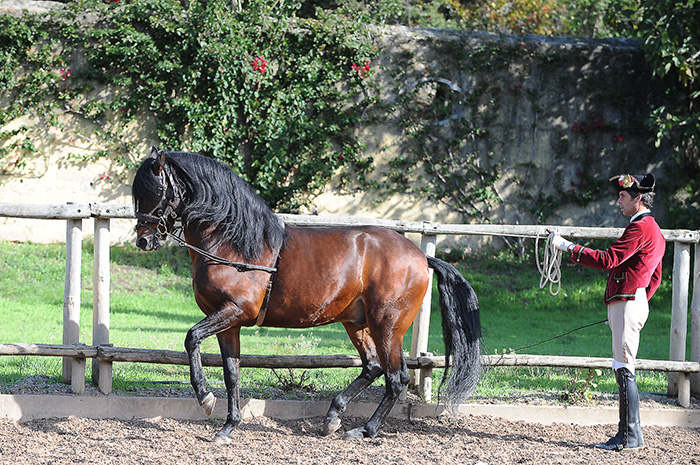
While we were in Lisbon, Miguel Távora took us to the Portuguese Royal School, headed by another disciple of Nuno, Filipe Graciosa. The members of our group were thrilled by the quiet, tactful riding of the School. It really is quite amazing to stand in the gardens of the Palace of Queluz watching horses schooled in the airs above the ground. It is as if you had been time transported back a couple of hundred years in time.
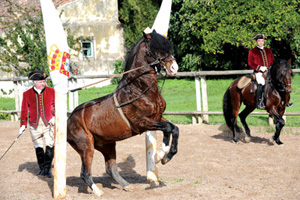
The organizers of the forum were serious in their attempts to learn how ‘the others’ had managed to produce their dressage horses, and had invited Axel Bröckmann, the head of the State Stud at Celle – the home of Hanoverian breeding, to address them.
Axel presented a neat outline of the way in which the Hanoverian breeders and administrators, using an open but not wide-open Stud Book, and strict controls on breeding stallions through performance tests, had gradually developed the breed, and in the process, a data gathering system that provided breeding values that identified the top stallions for breeding dressage or jumping horses.

“You need a clearly defined breeding goal. Conformation and type are highly correlated to dressage. A strict stallion performance test leads to the most success,” he advised.
It does sound so easy, a neat little formula for the Portuguese breeders to put into place. Performance tests + competition results = breeding values = successful dressage breeding. And the Hanoverians should know since they have won the World Breeding Federation for Sport Horse Dressage rankings over and over again. Haven’t they? Well, yes, but as I pointed out to my friend Axel, isn’t it true that the last time the Hanoverians won the title, 5/6th of the winning group were bred not for dressage but for jumping? The supplementary question that I didn’t get to ask was, why if the breeding values are so useful in guiding the breeders to the right stallions, is the most popular stallion at Axel’s Celle in the last season, Dancier, who has no breeding value at all since his first crop of foals will go under saddle in the New Year? The truth is that there is no correlation between a high dressage breeding value and lots of mares – indeed there might even be a negative correlation. Once more we learn to beware of administrators who can always find reasons for success in their regulations and programs, when the reality is usually a lot more messy and random.

The afternoon session with another old friend, Ulf Möller from Germany’s premier dressage barn, PSI, would seem to suggest that a great deal of the problem lies not in the genes of the horses but in the genes – or education – of the riders. Try as hard as he could, Ulf just could not get the Portuguese riders he was working with to let the horses stretch and relax and go forward. Some of the locals seemed to think that the tendency to stop was some sort of Lusitano breed characteristic rather than a result of bad backwards riding in double bridles. It was a pity that Ulf was not wearing his boots and breeches.
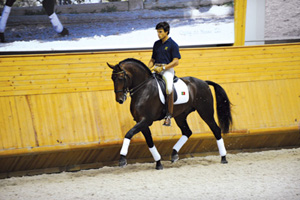
Daniel Pinto, who rode the last horse in Ulf’s session, has been heard to observe that to be a dressage rider in Portugal was as strange as being a bull-fighter in Germany… but that it was getting better.
One of the problems of being in Portugal is trying to get a hang on names… it is not just that the Portuguese have so many of them, but that even quite a simple name like Rodrigo, sounds nothing like that! The head of the Casa Cadaval Stud is the Countess Teresa Alvares Pereira Schonborn Wiesentheid, and her stud has been in operation since the seventeenth century.
However as the Stud Manager, Bento Castelhano explained in his presentation, ten years ago they started to breed for a more functional horse.
“We noticed that our horses had some characteristics that are not so common in the breed, bigger withers, more structured angles… our goal is dressage, a horse that is athletic in conformation and movement.”
The stud started a program of assessment from weanlings onwards, especially looking at easiness of handling and riding ability.
“We were surprised how quickly after we began this record keeping, we identified the good families and made great progress. Each year now when we are selecting the stallion for a particular mare, we check the records. We don’t have dressage competition information yet, so we use information from the more traditional riding classes and consumer feedback. It is an expensive process but we intend testing some of the animals we want to breed from in high level dressage competition.”
One thing Casa Cadaval is looking for is durability: “Our dressage horses are not going to be ‘consumed’ quickly, it will be a long time before they reach the highest levels of dressage. We were lucky, we were able to send two mares to Guizo, and that was not only because of the high scores he achieved in international dressage competition, but also the length of his career, and his bone structure.”
“More reliable knowledge is needed, with the help of the Azores University, we researched functional performance on the Casa Cadaval mares, and mares that were closely related to ours, and that helped us choose the lines we wanted. Because it is a closed stud book, we need to indentify, which families are performers, which families have problems? We are not in-breeding, but concentrating – when we went to other studs for stallions, we tried to use stallions with connections to our horses. We are aware of the risk of concentrating bloodlines, that’s why we keep our selection procedures objective.”
“But we are also breeding for beauty, that is very important for dressage, the horse needs to be striking to the eye, with harmony of shape, health and durability.”
The durability issue came to the fore with a presentation from the vet, Artur da Câmara Machado, who delivered a paper, The Lusitano towards the Future: Good genes, Bad genes.
Although there are still a few people with their heads buried firmly in the ground who will tell you that OCD is not hereditary but the consequence of bad diet, anyone who has looked at the situation seriously, knows that it is the product of a carrier gene. Professor Machado’s study of 161 Lusitano horses found that just on 30% of the horses had the gene that carries OCD. I’ve seen it before in Germany when similar findings have been revealed, the breeders just pretend it didn’t happen… Oh is that an elephant in the corner of the room, fancy, if we look the other way it will go away.
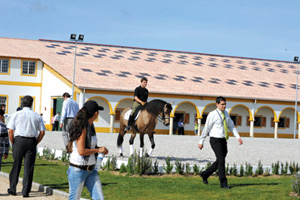
The Seminar was held at the Academie de Dressage Portugal, a branch of the breeding operation of Frenchman, Sylvain Massa, the Elevage Massa. While Mr Massa was not able to attend the Seminar, Daniel Pinto who heads up the Portuguese Centre, made a presentation on his behalf.
The stud was started 25 years ago when Massa bought horses in Portugal and it has become one of the ‘motors’ of breeding the new Lusitano Sporthorse. Right from the start Mr Massa involved that great luminary of Portuguese equitation and breeding, Guilherme Borba. According to Daniel:
“Sylvan invited Dr Borba to look at the seven mares in the field, and he said, ‘one of these mares is a little better than the others.’ A few months later, Sylvain invited Guilherme Borba to stay in his house. Once again they went to see the mares. There was only one, the not-so-bad one. Dr Borba asked, ‘where are the others?’ Sylvain said, ‘you have to tell me, from now on you are the advisor.’ After that they traveled together all over buying mares. So we had two starts, before Guilherme Borba and after Guilherme Borba.”
Massa currently has 50 mares at the breeding farm in France with the aim of 100 mares. The best of the young stock are sent to the Academie in Portugal for training.
“Sylvain wants to take Lusitano horses the medallist’s podium but he understands that with a closed book, he needs to keep his riders in the sport, so he crosses some Lusitano mares with Warmbloods. The objective is to one day have the purebred Lusitano on the podium but in the meantime it is important to keep the riders in the top sport.”
“It is the dream of Sylvan and me to one create a Lusitano horse to go into the sport with a walk for 9, a trot for 9, and a canter for 10.”
Daniel showed us a DVD of some of the foals from the breeding operation, and I am afraid I failed as a Lusitano connoisseur – the foals all looked a bit weak and out behind to me, until we got to one. That one can move! Yep, that was the one by the German Trakehner stallion, Munchausen. Currently Massa’s lineup of seventeen stallions, which features Daniel Pinto’s Olympic Lusitano, Galopin de la Font, also includes five sons of Munchausen.
Perhaps one of the most entertaining and exciting presentation of the Seminar came from the Brazilian breeder, Eduado Fischer from the Villa do Retiro. Manic is not sufficiently speedy to describe Mr Fischer in full flight. He started by apologizing for his English: “My English is like a credit card in the hands of my wife, impossible to control,” but you suspect that in any language he would be vaguely out of control…
He was seething at the impudence of the French equestrian press who at the World Cup Qualifier in Lyon, asked, aren’t you afraid that in five years, you will find that the Lusitano is not good enough for competitive dressage? “What do they mean, this weekend we have Poderoso do Retiro and Carlos Pinto at Lyon and Hayley Beresford and Relâmpago do Retiro at Paderborn, and they will both be in the big World Cup class at Frankfurt. We are here already. But our breed has two problems. One is the walk which must be improved but the worst fault is that we are a very small breed but we are split, we are not together. The Lusitano could be much better in five years if we create an international federation, an international company like the Dutch have, to own our top horses. Maybe this seminar is the first step to us all coming together.”
“How long has it taken the Germans and the Dutch to get to 70%? We started just five years ago, but fortunately our breed started 5000 years ago. I know we have the best horse in the world, now is the time to invest in the future.”
This is a very tame précis of the real thing.
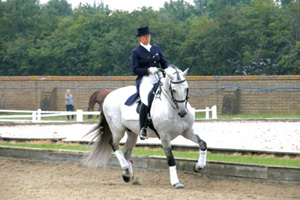
The newest star in the Lusitano lexicon is Rico, currently being campaigned in England by Kyra Kyrklund, so, of course, Kyra was star of the show at Lisbon.
She explained that five years ago at the Global Forum she became interested in Lusitanos after seeing Oxalis and Spartacus.
“I was very impressed and came to Portugal to work with your riders. The horse I took to the LA Games was an Andalusian, and I have always preferred sensitive horses. At the first clinic, I rode ten horses and at the end, I hadn’t even started to sweat, even though all the riders were men and usually it’s harder work riding men’s horses… since then I’ve spent the last four years working in Portugal.”
“What do we need in a Grand Prix horse? A horse with the ability to shorten, and collect, which should be easy for the Lusitano because that is a traditional strength. We also need a horse that can extend, but mainly we need a strong horse because when you train and train for Grand Prix, they break. You have to think how long you spend educating your horse to Grand Prix. I had to make all my Grand Prix horses, so I wanted to make sure they were strong.”
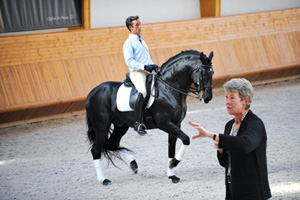
“There is nothing wrong with the German system of training, but it is very vertical, this, then this, then this. I too think rhythm and relaxation and all the things on the training scale are important, but I work a bit more horizontally. Even with a young horse, I think what do I need for pirouettes? Working backwards and forwards, piaffe is only a variation of trot, I want to feel passage and piaffe in the trot even if the horse can’t do them yet. Take advantage of ‘Ah Hah’ experiences. When Matador offered piaffe in the forest when he was four years old, I didn’t tell him off, and he did a lovely piaffe when he was five. People ask, what level is your horse? And I say, between Elementary and Grand Prix.”
“You pick the things a horse is good at, and as it becomes stronger, the weaker things become better. When the canter is stronger, then the changes get better. I started the first changes with Matador at six, and he did his first Grand Prix when he was seven, but then the flying changes improved. You try and make it easy for the horse. If you over-train the ones times flying changes, they get worse.”
And so how did she find the new wonder horse, Rico?
“About twelve months ago, we were invited to a breeders’ show at Cascais, it was one of those BLINK moments. I saw this horse, and how he carried himself and the rider, and the temperament he showed. One of the things I like about Lusitanos is that they are prepared to work, you can put them away, and bring them back and they work. I like the on/off button. With some of the heavier horses you almost have to get them angry to get the adrenalin. Lusitanos, like some Trakehners, some Thoroughbreds, have that ‘girl’ horse quality – a horse that wants to go without having to be pumped full of adrenalin. With Lusitanos you can’t force them, you have to ask.”
It was a year before Rico finally arrived at Kyra’s stables in the United Kingdom.
“He had never done a competition. First I had to get the connection. I had seen him do flying changes but he didn’t like my aids. You have to adapt, and he has to come to you.”
“The piaffe was a little wide behind, so I tried to teach him a completely new thing. The rider is a workman, he needs lots of tools. If you are getting the wrong result, try another way. If you have a screw and only a hammer, you can get it into the wall, but it will never be as strong as if you used a screw-driver. You are trying to find new tools all the time.”
“With Rico, I only did the piaffe work in hand – standing still, I touched him to try and get him to find the balance on three legs, I did that on both sides, then tried to combine it. I did this four times a day for five minutes each time, and in a couple of weeks, he started to get the idea. He’s a Grand Prix horse in the making, I am now working on the quality.”
“At home, one day I will do more trot, one day more canter – I try to work different muscle groups on different days. I’ll play with the half passes, quicker, slower, higher, lower. You hear people say ‘ride more forward’ – what do they mean? Longer steps and a longer body or shorter steps and more closed. It is important to shorten and quicken the step, then you can go forward and bigger.”
“His way of doing changes is lovely, relaxed, with energy, going forward. When there is a problem, it’s my fault. I want to move my leg more, and he wants me to keep my leg more forward and in place. I’ve started to feel that Grand Prix is at the end of the tunnel…”
Rico and Kyra won their first Grand Prix with over 70%, then the Inter I at Hartford with 76%, and then went on to win the big Kür at Hickstead… so will he be ready for Lexington?
“He may well be…”
It was Paulo Caetano who moved to thank the Finnish rider: “My dear friend Kyra, thanks. Your training with Rico is one of the most special moments in our Lusitano history.”
Boy, can these Portuguese talk! There was much, much more discussion and several more excellent papers, but by now I guess you have the flavor of the three days. Somehow it was decided there had to be a ‘conclusion’, so the discussion panel and the speakers were locked away – while we enjoyed more of the hospitality – until they came up with a joint statement:
Everybody recognizes the interest and the importance of the Lusitano Breed for Dressage.
Despite being a closed studbook, the breed has enough genetic diversity to allow selection for dressage.
The health and soundness are excellent but should be monitored constantly.
The communication between all involved parties: breeders, riders, owners and trainers as well as the national federations should be improved.
The forum acknowledges that through a correct and systematic training, which means following the Basic Training Scale, we will allow the Lusitano horse to show its full potential for dressage.
So was this the historic break-through the organizers were hoping for? Obviously one of the problems – referred to by Eduado Fischer – is the lack of unity within the breed. Many of the leading figures in the breed were conspicuous by the absence, or only put in a brief appearance on the first day, but I guess the history of performance horse breeding proves one thing, it is usually more likely the result of the efforts of individual breeders than the fine intentions of breed society officials, and the Lusitano horse has breeders aplenty with the fire and passion to take the breed to the next level…
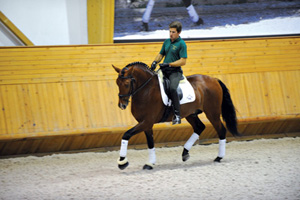
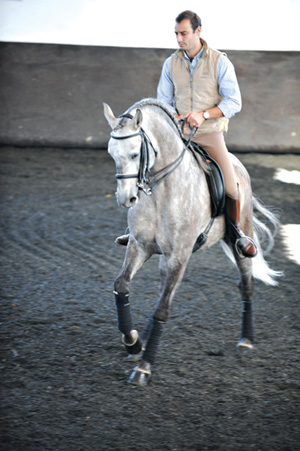
Rodrigo Torres: the New Master
We were very lucky that Miguel Tavora took us to see Rodrigo Torres, the young man who many view as ‘the new’ Nuno Oliveira. It must be a seriously worrying title for such a modest and charming young man, especially as he has only seen Nuno on film.
Rodrigo – unlike Nuno – competes regularly in Working Equitation and also in straight Dressage competitions, which is wonderful. Great as Mestre Oliveira’s influence has been, it would have been so much greater if he had led a Portuguese team to take on the rest of the world at a time when the world of dressage was much less set in its ways. An Olympic medallist Nuno could have had a huge positive influence o the development of dressage. As Miguel Tavora remarked, competition dressage isn’t perfect, but as a reality test it’s a lot better than looking at yourself in the mirror of your own rider hall…
For me, it was a very special moment to sit in the indoor arena of Torres Vaz Freire Stud and watch 32 year old Rodrigo Torres work his horses, and right from the start it proved that when these Lusitano horses are nice, they are very fine indeed.
When we arrived, Rodrigo was working a rose grey five year old stallion (they are all stallions in this country). The horse was so sweetly forward, engaged and athletic. Triple canter pirouettes, two times changes… is this too much for a baby? Seemingly not, Rodrigo drops the rein and the horse is so calm and relaxed. And this seems to happen with all the horses this gifted young man rides, give the rein and they unhesitatingly take it, and it is seldom indeed that you see a tail swish. Some of our group were a bit taken back by piaffe being used as a warmup exercise but I seem to remember that the great German rider, and student of the Spanish School of Vienna, Richard Wätjen, recommended a bit of piaffe to get rid of stable stiffness.
Rodrigo invites the head of our group, Miguel Távora, to have a ride on the third horse, a chunky older stallion, and of course the horse works perfectly for him. This is one of the aims of Classical Equitation, to produce a horse so perfectly trained that any educated rider can climb on board and all the buttons work.
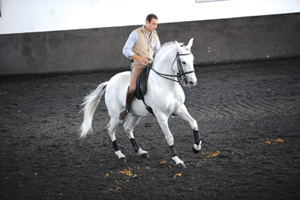
One of the more famous horses in the stable is the eleven year old Raja, the sire of the first horse we saw. It is amazing that Rodrigo can ride the horse in the most amazing piaffe and then go instantly into a totally immobile halt – and I mean into it, it is halt almost as an upward transition! And yes, he rides a canter pirouette in counter canter… truly amazing.
Perhaps the most exciting horse of all is the five year old dark brown, Zimbro. This is the perfect type for competition dressage and he is absolutely cool and relaxed even though he is doing all the movements of the Grand Prix and then some – voltes of changes, triple pirouettes… toss him the rein, and he is relaxed. Miguel rides him, getting great steps of piaffe and passage, and once again, those perfect, dead square, absolutely still, halts.
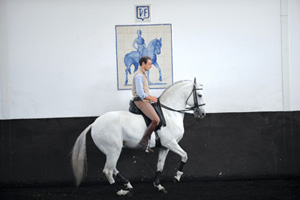
If I told my friends, oh I have seen a five year old stallion doing all the advanced movements of the Grand Prix, they would say to me, oh the horse must be crazy and the rider also, but the horse is not pressurized, when you drop the rein he is cool…
“He is completely relaxed. The way to do this, is when you have a very strong horse with so much talent to do all the exercises, and you put that horse in a good balance, you can begin to make some steps of all the exercises, not many steps, just a few steps. Few steps of piaffe, a few steps of passage, and he will begin step by step to be stronger in the body. You need to build this very slowly but when you put the body of the horse in this balance, you can do it.”
But this is an exceptional horse?
“An exceptional horse. In my breeding I have been searching for some horses with this talent. I rode all the stallions, and I know all the mares, that makes it easier to produce a horse like this.”
You also ride in competition dressage? You would like to compete for Portugal?
“Of course, why not? When the horse is ready, then I will try. But I am a breeder, and for me it is not very easy because it is expensive to stay in the competition, but I want to try.”
But many riders, particularly those associated with Nuno Oliveira, they had the attitude, competition riding is bad, it is not the high art of riding?
“For me what I really like is to teach the horses. I try to understand the way to teach all the horses – when they have problems, when they don’t have so much talent to do one thing, this is what I really like, but it is important for me to compete also. I think it is the same, of course to compete, then I need to change some things – to put the horse more strong in the back and to relax the horse more. The steps need more swing all the time, so I need to change some things in my work.”
Were you always going to become a rider?
“Since three years old. When I was sixteen I made my first horse that could do all the movements. He was eight years old – we still have him, he is very old, 25 years old.”
Do you feel yourself to be in the tradition of Nuno Oliveira?
“I just saw Nuno Oliveira riding in movies. I see some things in him that I can be more or less in the same way, but I never learned with him. Maybe it is what I feel about horses, maybe when I feel the horse, I don’t know if I feel the same things he felt, maybe? Some of the pupils of him, say I am like him, but I don’t know.”
I found it interesting, when you ride, at any moment you can come to total immobility…
“That is very important. I can’t say how I do this, there are things I need to feel, I try to keep it in myself and in the horse – put the body and the balance of the horse in the good way. You must feel this…”
Nuno used to read many old books – are you a reader of the Old Masters too?
“No. Maybe I have read one old book, I am not so much of a reader, the horses tell me what I need to know.”
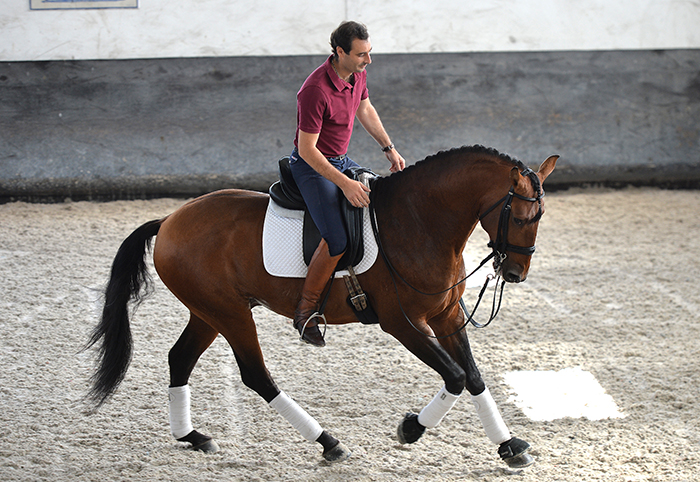
This article first appeared in the February 2010 edition of The Horse Magazine



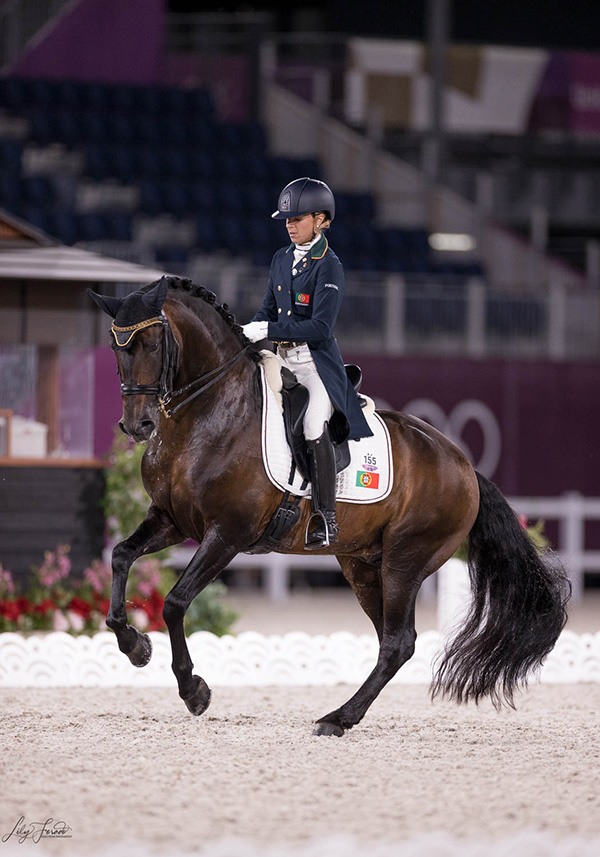

Wonderful writing on an event I could not attend. It was like being there,Regards,Gareth.
Excellent capture of extensive material. Well done!
I was curious about the Lusitano participants in the Olympics, now I have the pictures. Thank you. Here in the US it’s hard to find Equestrian broadcasts or streams that show all dressage participants.
Well done